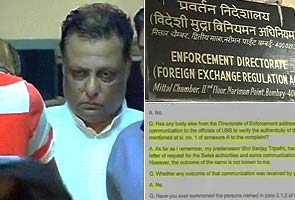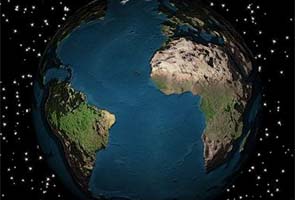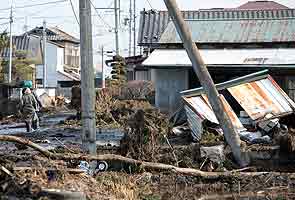Tokyo: Japanese officials struggled on Sunday to contain a widening nuclear crisis in the aftermath of a devastating earthquake and tsunami, saying they presumed that partial meltdowns had occurred at two crippled reactors and that they were bracing for a second explosion, even as they faced serious cooling problems at four more reactors. (
Watch: Explosion at Fukushima nuclear power plant)
The emergency appeared to be the worst involving a nuclear plant since the Chernobyl disaster 25 years ago. The developments at two separate nuclear plants prompted the evacuation of more than 200,000 people. Japanese officials said they had also ordered up the largest mobilization of their Self-Defense Forces since World War II to assist in the relief effort. (
See pics: Japan earthquake triggers tsunami)
On Saturday, Japanese officials took the extraordinary step of flooding the crippled No. 1 reactor at Fukushima Daiichi Nuclear Power Station, 170 miles north of Tokyo, with seawater in a last-ditch effort to avoid a nuclear meltdown. That came after an explosion caused by hydrogen that tore the outer wall and roof off the building housing the reactor, although the steel containment of the reactor remained in place.
Then on Sunday, cooling failed at a second reactor -- No. 3 -- and core melting was presumed at both, said the top government spokesman, Chief Cabinet Secretary Yukio Edano. An explosion could also rock the No. 3 reactor, Mr. Edano warned, because of a buildup of hydrogen within the reactor.
"The possibility that hydrogen is building up in the upper parts of the reactor building cannot be denied. There is a possibility of a hydrogen explosion," Mr. Edano said. He stressed that as in the No. 1 unit, the reactor's steel containment would withstand the explosion. (
Watch: Japan, the day after)
"It is designed to withstand shocks," he said.
Officials also said they would release steam and inject water into a third reactor at the Fukushima Daiichi plant after temperatures rose and water levels fell around the fuel rods.
Cooling had failed at three reactors at a nuclear complex nearby, Fukushima Daini, although he said conditions there were considered less dire for now.
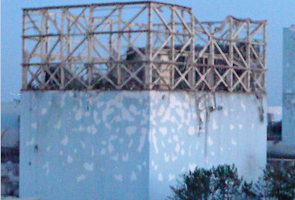
With high pressure inside the reactors at Daiichi hampering efforts to pump in cooling water, plant operators had to release radioactive vapor into the atmosphere. Radiation levels outside the plant, which had retreated overnight, shot up to 1,204 microsieverts per hour, or over twice Japan's legal limit, Mr. Edano said.
NHK, Japan's public broadcaster, flashed instructions to evacuees: close doors and windows; place a wet towel over the nose and mouth; cover up as much as possible. At a news conference, Mr. Edano called for calm. "If measures can be taken, we will be able to ensure the safety of the reactor," he said.
Even before Mr. Edano's statement on Sunday, it was clear from the radioactive materials turning up in trace amounts outside the reactors that fuel damage had occurred. The existence or extent of melting might not be clear until workers can open the reactors and examine the fuel, which could be months from now.
The Japanese Nuclear and Industrial Safety Agency said that as many as 160 people may have been exposed to radiation around the plant, and Japanese news media said that three workers at the facility were suffering from full-on radiation sickness.
Even before the explosion on Saturday, officials said they had detected radioactive cesium, which is created when uranium fuel is split, an indication that some of the nuclear fuel in the reactor was already damaged.
How much damage the fuel suffered remained uncertain, though safety officials insisted repeatedly through the day that radiation leaks outside the plant remained small and did not pose a major health risk.
However, they also told the International Atomic Energy Agency that they were making preparations to distribute iodine, which helps protect the thyroid gland from radiation exposure, to people living near Daiichi and Daini.
Worries about the safety of the two plants worsened on Saturday because executives of the company that runs them, Tokyo Electric Power, and government officials gave confusing accounts of the location and causes of the dramatic midday explosion and the damage it caused.
Late Saturday night, officials said that the explosion at Daiichi occurred in a structure housing turbines near its No. 1 reactor at the plant, rather than inside the reactor itself. But photographs of the damage did not make clear that this was the case.
They said that the blast, which may have been caused by a sharp buildup of hydrogen when the reactor's cooling system failed, destroyed the concrete structure surrounding the reactor but did not collapse the critical steel container inside. This pattern of damage cast doubt on the idea that the explosion was in the turbine building.
"We've confirmed that the reactor container was not damaged," Mr. Edano said in a news conference on Saturday night. "The explosion didn't occur inside the reactor container. As such there was no large amount of radiation leakage outside. At this point, there has been no major change to the level of radiation leakage outside, so we'd like everyone to respond calmly."
On Sunday morning, an official with Tokyo Electric Power said that the emergency cooling system at the No. 3 reactor at Daiichi had stopped working. The official, Atsushi Sugiyama, said that urgent efforts were being made to cool the reactor with water, and that, as with the first reactor, there would be a release of vapor containing trace amounts of radiation to relieve a buildup of pressure.
Japanese nuclear safety officials and international experts said that because of crucial design differences, the release of radiation at Daiichi would most likely be much smaller than at Chernobyl even if the plant had a complete core meltdown, which they said it had not.
After a full day of worries about the radiation leaking at Daiichi, Tokyo Electric Power said an explosion occurred "near" the No. 1 reactor at Daiichi around 3:40 p.m. Japan time on Saturday. It said four of its workers were injured in the blast.
The decision to flood the reactor core with corrosive seawater, experts said, was an indication that Tokyo Electric Power and Japanese authorities had probably decided to scrap the plant. "This plant is almost 40 years old, and now it's over for that place," said Olli Heinonen, the former chief inspector for the I.A.E.A., and now a visiting scholar at Harvard.
Mr. Heinonen lived in Japan in the 1980s, monitoring its nuclear industry, and visited the stricken plant many times. Based on the reports he was seeing, he said he believed that the explosion was caused by a hydrogen formation, which could have begun inside the reactor core. "Now, every hour they gain in keeping the reactor cooling down is crucial," he said.
But he was also concerned about the presence of spent nuclear fuel in a pool inside the same reactor building. The pool, too, needs to remain full of water to suppress gamma radiation and prevent the old fuel from melting. If the spent fuel is also exposed -- and so far there are only sketchy reports about the condition of that building -- it could also pose a significant risk to the workers trying to prevent a meltdown.
Both Daiichi and Daini were shut down by Friday's earthquake, but the loss of power in the area and damage to the plants' generators from the ensuing tsunami crippled the cooling systems. Those are crucial after a shutdown to cool down the nuclear fuel rods.
The malfunctions allowed pressure to build up beyond the design capacity of the reactors. Early Saturday, officials had said that small amounts of radioactive vapor were expected to be released into the atmosphere to prevent damage to the containment systems and that they were evacuating people in the area as a precaution.
Those releases apparently did not prevent the buildup of hydrogen inside the plant, which ignited and exploded Saturday afternoon, government officials said. They said the explosion itself did not increase the amount of radioactive material being released into the atmosphere. However, safety officials urged people who were not evacuating but still lived relatively nearby to cover their mouths and stay indoors.
David Lochbaum, who worked at three reactors in the United States with designs similar to Daiichi, and who was later hired by the Nuclear Regulatory Commission to teach its personnel about that technology, said that judging by photographs of the stricken plant, the explosion appeared to have occurred in the turbine hall, not the reactor vessel or the containment that surrounds the vessel.
The Daiichi reactor is a boiling-water reactor. Inside the containment, the reactor sends its steam out to a turbine. The turbine converts the steam's energy into rotary motion, which turns a generator and makes electricity.
But as the water goes through the reactor, some water molecules break up into hydrogen and oxygen. A system in the turbine hall usually scrubs out those gases. Hydrogen is also used in the turbine hall to cool the electric generator. Hydrogen from both sources has sometimes escaped and exploded, Mr. Lochbaum said, but in this case, there is an additional source of hydrogen: interaction of steam with the metal of the fuel rods. Operators may have vented that hydrogen into the turbine hall.
Earlier Saturday, before the explosion, a Japanese nuclear safety panel said the radiation levels were 1,000 times above normal in a reactor control room at Daiichi. Some radioactive material had also seeped outside, with radiation levels near the main gate measured at eight times normal levels, NHK quoted nuclear safety officials as saying.
The emergency at Daiichi began shortly after the earthquake struck Friday afternoon. Emergency diesel generators, which kicked in to run the cooling system after the electrical power grid failed, shut down about an hour after the earthquake. There was speculation that the tsunami had flooded the generators, knocking them out of service.
For some time, the plant was able to operate in a battery-controlled cooling mode. Tokyo Electric Power said that by Saturday morning it had also installed a mobile generator to ensure that the cooling system would continue operating even after reserve battery power was depleted. Even so, the company said it needed to conduct "controlled containment venting" in order to avoid an "uncontrolled rupture and damage" to the containment unit.
Why the controlled release of pressure did not succeed in addressing the problem was not immediately explained. Tokyo Electric Power and government nuclear safety officials also did not explain the precise sequence of failures at the plant.
Daiichi and other nuclear facilities are designed with extensive backup systems that are supposed to function in emergencies to ensure the plants can be shut down safely.




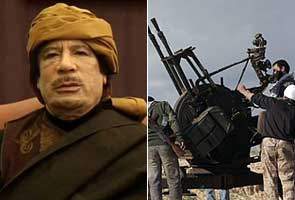
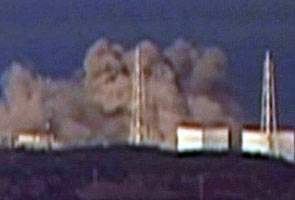
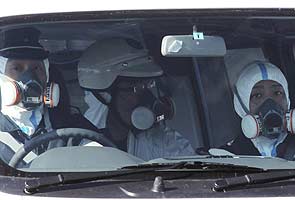
 Click to Expand & Play
Click to Expand & Play



